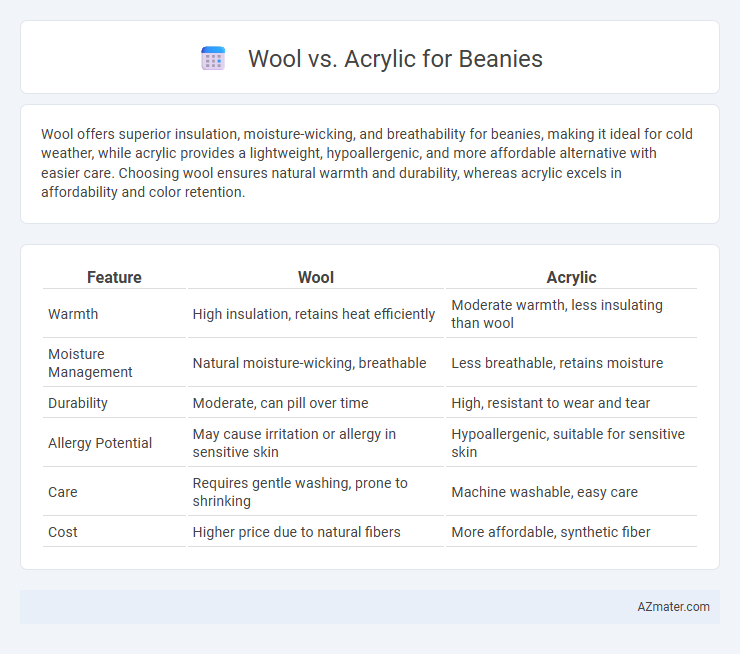Wool offers superior insulation, moisture-wicking, and breathability for beanies, making it ideal for cold weather, while acrylic provides a lightweight, hypoallergenic, and more affordable alternative with easier care. Choosing wool ensures natural warmth and durability, whereas acrylic excels in affordability and color retention.
Table of Comparison
| Feature | Wool | Acrylic |
|---|---|---|
| Warmth | High insulation, retains heat efficiently | Moderate warmth, less insulating than wool |
| Moisture Management | Natural moisture-wicking, breathable | Less breathable, retains moisture |
| Durability | Moderate, can pill over time | High, resistant to wear and tear |
| Allergy Potential | May cause irritation or allergy in sensitive skin | Hypoallergenic, suitable for sensitive skin |
| Care | Requires gentle washing, prone to shrinking | Machine washable, easy care |
| Cost | Higher price due to natural fibers | More affordable, synthetic fiber |
Introduction to Beanie Materials
Beanie materials like wool and acrylic each offer distinct advantages in terms of warmth and durability. Wool provides natural insulation, moisture-wicking properties, and breathability, making it ideal for cold weather. Acrylic, a synthetic fiber, is lightweight, hypoallergenic, and resistant to shrinking, often used as a cost-effective alternative to wool in beanie manufacturing.
What is Wool?
Wool is a natural fiber obtained from sheep and other animals, known for its superior insulating properties and moisture-wicking ability, making it ideal for beanies in cold weather. Its natural crimp provides elasticity and durability, ensuring long-lasting comfort and warmth. Wool's breathability helps regulate temperature, reducing overheating and keeping the head dry during outdoor activities.
What is Acrylic?
Acrylic is a synthetic fiber made from polymerized acrylonitrile, designed to mimic natural wool's softness and warmth while offering increased durability and resistance to moisture and moths. Acrylic fibers are lightweight, hypoallergenic, and maintain color vibrancy longer than wool, making acrylic beanies ideal for those seeking easy-care and affordable headwear. Compared to wool beanies, acrylic options provide greater elasticity and faster drying times without sacrificing warmth.
Warmth and Insulation Comparison
Wool beanies offer superior warmth and natural insulation due to their ability to trap air within the fibers, providing excellent heat retention even in damp conditions. Acrylic beanies, while lightweight and moisture-resistant, generally provide less insulation and retain less heat compared to wool. Wool's breathability and temperature regulation make it the preferred choice for cold-weather beanies, outperforming acrylic in maintaining consistent warmth.
Comfort and Softness: Wool vs Acrylic
Wool offers natural insulation and breathability, providing warmth while wicking moisture away from the skin for enhanced comfort. Acrylic fibers are lightweight and soft, often mimicking wool's texture but can lack the same breathability and moisture management. For prolonged wear against sensitive skin, wool may feel itchier, whereas acrylic tends to be smoother and more hypoallergenic.
Durability and Longevity
Wool beanies offer superior durability and longevity due to their natural resilience, moisture-wicking properties, and resistance to pilling, which helps maintain shape and warmth over time. Acrylic beanies, while generally more affordable and resistant to moth damage, tend to wear out faster, losing softness and elasticity after repeated washing. Choosing wool ensures a longer-lasting beanie that withstands cold weather and frequent use better than acrylic alternatives.
Allergies and Skin Sensitivity
Wool beanies made from natural fibers like merino or alpaca offer excellent breathability and moisture-wicking properties but may cause irritation or allergic reactions in individuals with sensitive skin or wool allergies due to lanolin content. Acrylic beanies provide a hypoallergenic alternative that is less likely to provoke allergic responses and generally soft on sensitive skin, making them suitable for people prone to eczema or dermatitis. Choosing between wool and acrylic requires considering personal skin sensitivity, with acrylic often preferred for its non-irritating synthetic fibers.
Care and Maintenance Requirements
Wool beanies require gentle hand washing in cold water and air drying to prevent shrinkage and maintain fiber integrity, while acrylic beanies are machine washable and more resistant to stains and wrinkles. Wool's natural lanolin content demands careful handling to avoid felting, whereas acrylic fibers tolerate frequent laundering and quicker drying without losing shape. Proper care extends the lifespan of both materials but wool needs more delicate maintenance compared to durable, low-maintenance acrylic beanies.
Environmental Impact and Sustainability
Wool beanies offer superior environmental benefits due to their renewable, biodegradable nature and minimal processing requirements, reducing carbon footprint compared to synthetic fibers. Acrylic beanies, derived from petroleum-based products, contribute to microplastic pollution and have a higher energy consumption during production, impacting sustainability negatively. Choosing wool supports sustainable farming practices and natural fiber recycling, making it a more eco-friendly option for beanie materials.
Cost and Value Considerations
Wool beanies typically cost more upfront due to natural fiber processing, but their superior insulation, breathability, and durability often provide greater long-term value. Acrylic beanies are more affordable and easier to care for, appealing to budget-conscious buyers seeking lightweight warmth and vibrant color options. Evaluating cost alongside factors like warmth retention and wear resistance helps determine the best value for differing needs in winter headwear.

Infographic: Wool vs Acrylic for Beanie
 azmater.com
azmater.com